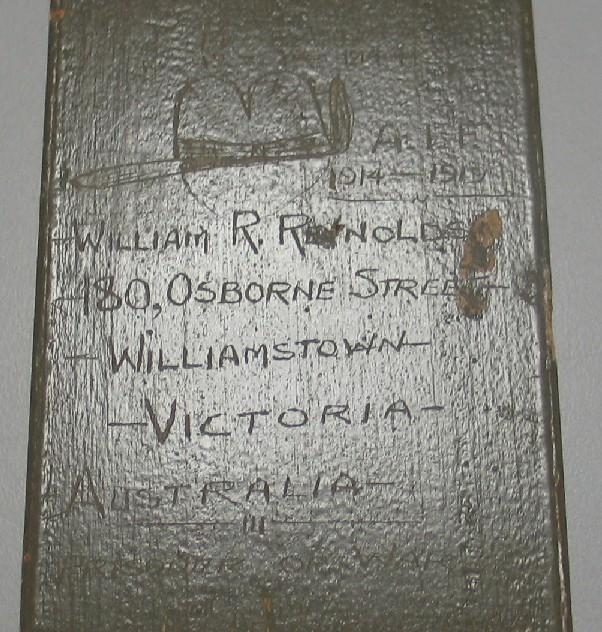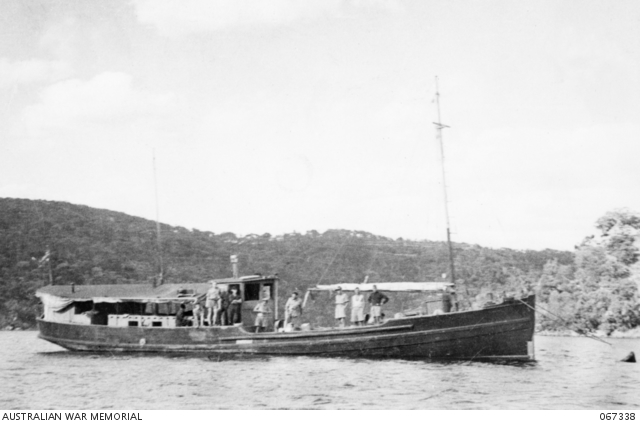Bill Reynolds MBE
A recent inquiry from a member of the public brought to my attention an interesting collection item held by the Memorial. It relates to Captain William Roy 'Bill' Reynolds from Victoria, who had served with the Merchant Navy, as well as working for a number of companies through Southeast Asia in the lead up to the Second World War.

The item in question is a piece of timber, cut from a door frame in the building where Bill Reynolds was imprisoned from late November 1943 to early February 1944 by the Japanese. Bill Reynolds was a bit of an adventurer and is probably best known for owning the vessel that became famous in Operation Jaywick as the 'Krait'. Trying to piece together his story is a bit of a challenge, there are many instances of records not existing or being hard to find, or contradicting each other. Extensive research into Bill Reynolds was done by Major Tom Hall, which was then published in the early 1990s by Lynette Ramsay Silver in her books 'Krait : the fishing boat that went to war' and 'The heroes of Rimau : unravelling the mystery of one of World War II's most daring raids'. In previous books about the Krait there was usually only a small amount of information about Reynolds and his activities.
In early 1942, as the Japanese advanced and then took Singapore, Reynolds did extensive work in rescuing evacuees around Malaya, including survivors from vessels attacked by Japanese aircraft. He did this in a vessel called the Kofoku Maru - a Japanese fishing vessel he acquired in Singapore. Before leaving Malaya, Reynolds renamed the vessel Suey Sin Fah and with his Chinese crew, made his way to India, using the insignificant fishing vessel as a disguise to get through Japanese controlled waters.
The Suey Sin Fah was later selected for a mission to clandestinely enter Singapore Harbour to destroy enemy vessels with limpet mines. For this mission the vessel was renamed the Krait, after a thin and innocuous looking, but very poisonous snake. Reynolds was to take part in this mission to Singapore, called 'Operation Jaywick', however due to engine problems the operation was postponed. Bill Reynolds was then employed by American Intelligence and was replaced for Operation Jaywick, which eventually took place, using the Krait, in September 1943. Reynolds accepted a mission to return to Malaya to collect intelligence for the Americans. He planned to purchase a junk and make his way south through Japanese occupied areas to Western Australia, posing as a man who wanted to purchase rubber and quinine.
Reynolds was taken to Malaya in the submarine, USS Tuna, and on the night of 13/14 November 1943 was deposited in a small boat off Laut Island, near Borneo. Unfortunately a few days after his arrival in the area, some villagers revealed Reynold's presence to the Japanese and he was taken prisoner on 18 November. He was held at Kota Bahru for eight days before being moved to Balikpapan on 26 November.

At Balikpapan, Reynolds marked off the days of his imprisonment on the piece of door frame.
During the months he was imprisoned at Balikpapan Reynolds scratched messages in the door frame of his prison. Due to the nature of his mission he would have known that his capture and fate would probably not be recorded by the Japanese. There would also be few records in Australia or America about his mission. He no doubt also knew the chances of surviving captivity were slim and may have been concerned that his wife and son (William Slevin Reynolds, who was serving in the Royal Australian Navy) would not find out what happened to him. Therefore the messages on the frame are very detailed. He made sure that there was a record of his presence there, as it would likely be the only tangible piece of evidence of what happened to him.

Reynold’s details on the door frame.
In order for it to be easily noticed, he scratched the image of a slouch hat and the text 'A.I.F. 1914-1919'. The slouch hat is instantly recognisable as an Australian symbol and he used it as such. Reynolds however, did not serve in the AIF during the First World War - he was living in England during the war and served with the Royal Naval Reserve.
Reynolds left details of his full name and address in Williamstown, Victoria. He also listed previous places of employment in Malaya and Borneo. These would help establish who he was, and the inclusion of the address would probably also have been recorded with the hope that someone would contact his family and let them know what had happened to him. Importantly for any war crimes investigators or future researchers, he also left details of where he had been held and for how long.

Reynold’s last inscription, February 1944.
On 10 February 1944 Reynolds was moved to Surabaya in Java. The date is noted on the door frame and seems to be scratched hurriedly. This is the last piece of information he left. He was held at Surabaya in solitary confinement for six months. On the morning of 8 August 1944 he was among several prisoner executed by the Japanese. Some of the prisoners were killed by decapitation, while the rest were executed by firing squad. Reynolds was one of the latter. His body was buried in an unmarked grave.
The building in Balikpapan was searched by members of 7 Division, AIF in August 1945. They discovered Reynolds messages and cut away the piece of door frame as evidence. It was donated to the War Memorial in 1946.
Reynolds was not the only person held in the small building in Balikpapan. After he was transferred to Surabaya, an unknown prisoner also scratched a message into the door frame, obscuring some of Reynold's writing. It is hard to make out properly, but this message consists of a cross scratched into the frame and the words 'JEZUS PELEPAS PERTJALAH'.
Member of the Order of the British Empire (Civil), REL/12760, https://www.awm.gov.au/collection/C94910
For his activities in rescuing evacuees around Malaya in 1942, Reynolds had been awarded the Member of the Order of the British Empire (Civil) which was promulgated on 17 August 1943 in the London Gazette. The medal was presented to his widow, Brigid Reynolds at Government House in Melbourne Victoria on 13 November 1946 by the Governor General, His Royal Highness The Duke of Gloucester. It is currently on display, along with a model of the Krait, in the Memorial's galleries.

